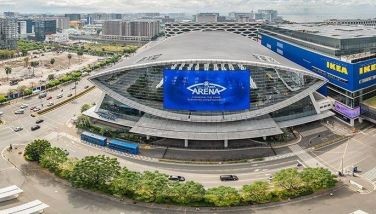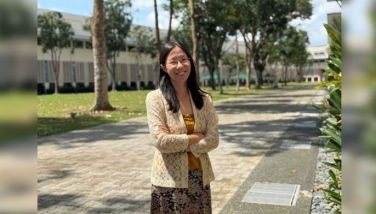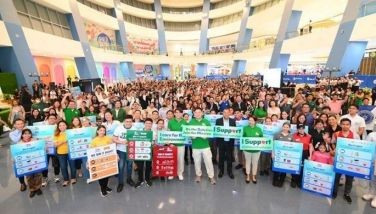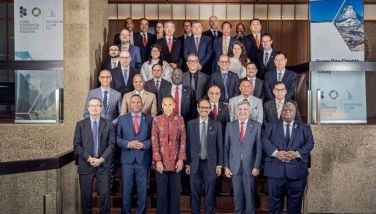Surprise, surprise
In years of watching fashion shows, I have come to one resolution: Don’t expect too much; don’t expect the worst, either. Don’t expect anything at all, in fact. You usually enjoy yourself more.
Philippine Fashion Week ’09’s very first group show, the Premier Collection A, was that kind of show that just takes your unsuspecting senses by surprise. As far as first shows go, this collective staging proves just how far local design and Philippine Fashion Week (PFW) has come. And how much both have improved over the years.
Though there were overlapping designs and styles with many of the six designers’ collections, this collective show did show global influences interpreted with local creativity and panache. Philippine Fashion Week’s first collective showing may not have been mind-blowing but it was still pleasant in the most surprising way.
Angelo Estera
It’s usually all in the details, which is what Estera’s collection mostly banks on. Appliqués, beading, color blocking and piping, lace — both cut-out and romantic — were all over Estera’s tailored clothing and gave an extra push to fitted pants, sleek shift dresses and chic suit jackets.
Estera claims his clothes as everyday wear, and they can be, for the sophisticated city couple. Working with a mostly black and bleak salmon palette, Estera’s clothes speak with the precise positioning of his details: cut-out lace overlay over a draped skirt, color-blocking on a winged asymmetric minimalist dress, piping on the lapels of a finely-constructed suit. It’s luxurious yet understated and, in its own way, works.
Jerome Salaya Ang
There seem to be so many ideas and concepts that went into Jerome Salaya Ang’s collection that the cohesiveness only came about with the headwear that the designer chose to put on his models: fancy, feather and bead-adorned caps, clips and hats that give a chic flightiness to his clothing.
Mixing asymmetric trends, printed plaid and both soft and heavy fabric, Salaya Ang’s clothes push the convention in a way but still remain, if not wearable, then still desirable. Long gowns and cocktail dresses with draped details are some of his best pieces — and he can get away with even just these.
Joel Escober
Evening wear has always been Joel Escober’s strong point but while his long gowns once again prove great construction and an ease with recreating refined elegance, it is Escober’s separates and his less formal pieces that stood out this time around. Taking notice of today’s trend for austerity and line, Escober includes sleek pencil-cut skirts and subtly fluid tops to his collection. But there is still a touch of softness in his pieces, an understated infusion of romanticism, as if he were creating for the no-nonsense woman on top that, deep within, still harbors the idealistic dreaminess of a teenage girl. “My designs aim to bring back the forgotten romance of the ‘80s and echo the romantic side of the woman beyond the glitz and glamour of the external,” says Escober.
You can also see the juxtaposition in sleek dresses, both long and short, heavily accentuated with curved, very evocative appliqués and his use of heavy jersey to create flowy jumpsuits.
Towards the end, Escober’s signature finally becomes more evident. A long teal blue striated gown draws approval with its low back and his final dress, another long gown, this time green with gold trimming, fully expounds on the designer’s intention. In practical times, romanticism is a gamble but Escober pulls it off as if he was Cupid.
Randall Solomon
Solomon’s collection, entitled “A Slight Fever,” may have earth-friendly concerns, as evidenced by his use of somber earth tones and organic-looking wool and cotton, mostly for his menswear. However, it is his black, less conscientious pieces that are more favorably memorable in his collection.
Solomon shows an affinity for drapery, ruching and detail with dresses that seem to bring out every woman’s inherent sexiness. His clean construction echoes fluid silhouettes that combine modernity and wearability. Black jersey dresses with all-over draping, possibly a suggestion of “fossils and rock formations” would look good on any figure, which should gratify a great many women. The designer, who showed in Fashion Week for the first time, also focuses on detailed closures. Closer looks would reveal a focus on zippers, metals and leather to complement all the black, just enough to give a certain cheekiness to all the fluidity.
Raoul Ramirez
Obviously (or maybe hopefully), Raoul Ramirez was being ironic when he showed pieces styled for below-zero, or close to it, weather. His mostly-white collection, starting off with a white, tactile trench coat (that perhaps would have been more effective on a taller model) could be deemed impractical if taken at face value. But literal notions aside, and with enough dissection, Ramirez’s pieces show a tropical proclivity. There’s the monotonous use of white, to start off, which in Arctic, snow-packed weather is rarely an option.
White, and its various shades (interspersed with some paler grays and pinks) also give more sophistication to his clean lines and precise tailoring. This collection is for stylish urbanites who refuse to be cowed by trends and would rather favor timeless effortless chic. This is highly visible in an ensemble made up of a pleather off-white pencil-cut skirt and pink, pailette-heavy top. Also on a white crinkled dress accentuated with what can pass as a capelet and a dress with leg-of-mutton sleeves. Says Solomon, “My designs reference the different whimsical forms of nature, with hints of modernism and futurism that result in timeless pieces for all seasons.”
Yako Reyes
Probably the biggest surprise of the collective show came from Yako Reyes, who drew nods for his no-nonsense, spartan, Japanese minimalist clothes. More so considering that Reyes is not even a clothing designer. In fact, the real stars of his collection were his bags: nylon and synthetic rubber pieces that are as bare and as utilitarian as his clothes. “The clothes were actually just props for my bags,” Reyes reveals in a deadpan tone. “I don’t really know how to make clothes so I just came up with something anti-body, minimal and utilitarian.” If you’re into disturbingly stark, wear-easy clothing, Reyes’ non-designer revelation should be the biggest understatement of Philippine Fashion Week. Shapeless shifts, non-descript shirts and bottoms and sleek, simple pull-ons were fitting “props” to the designer’s array of bags.
Designing under the label Baggets (available at the Ramp, Crossings in Shangri-la and Market! Market!) Reyes’ bags may look simple and anti-trend but he proves his mettle by coming up with the first solar-paneled bags manufactured locally. Called Solaris, his 30-piece collection includes eight bags fitted with solar panels good enough to charge small gadgets such as mobile phones and digicams. “My intent is to make solar-paneled bags mainstream so they won’t be too expensive to make.”
Serviceable design is obviously Reyes’ real intent. “I don’t want to put anything on my bags that is not functional.” Even his bags that are not outfitted with solar panels, from duffels to body bags, are huge, roomy, ergonomic and body-friendly. And, just like his clothes, efficiently minimalist and precisely structured.
















